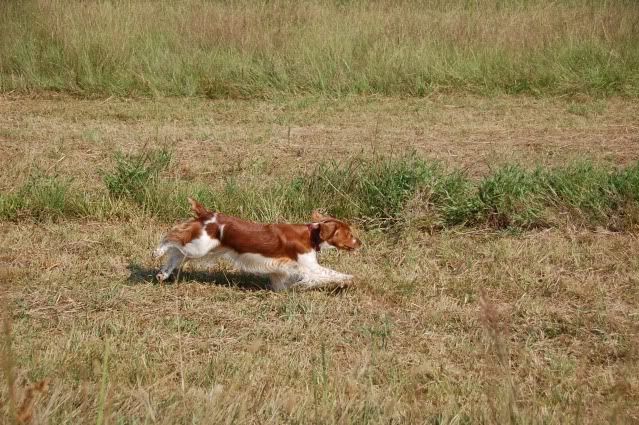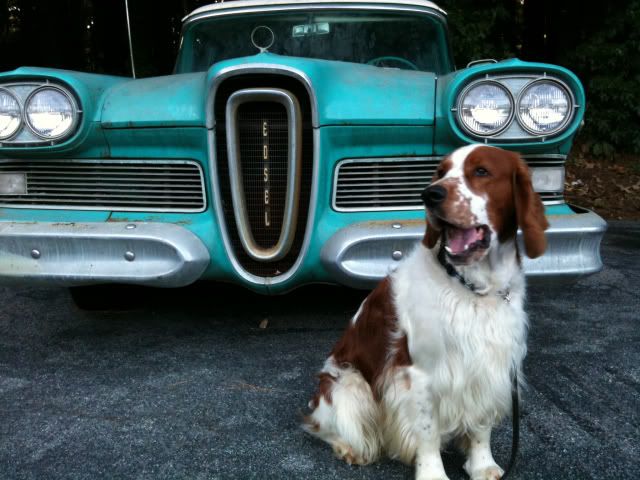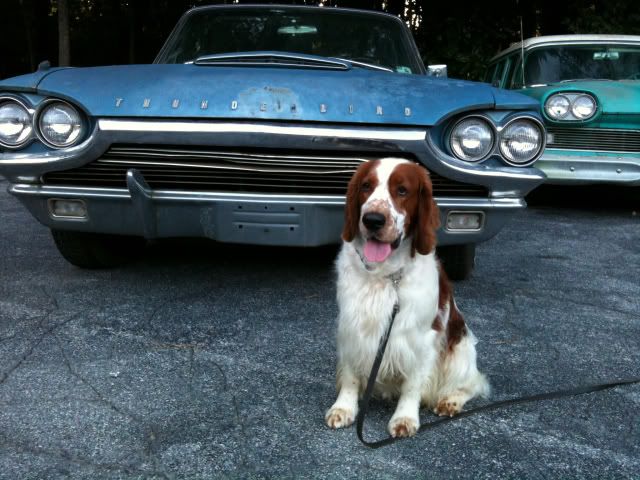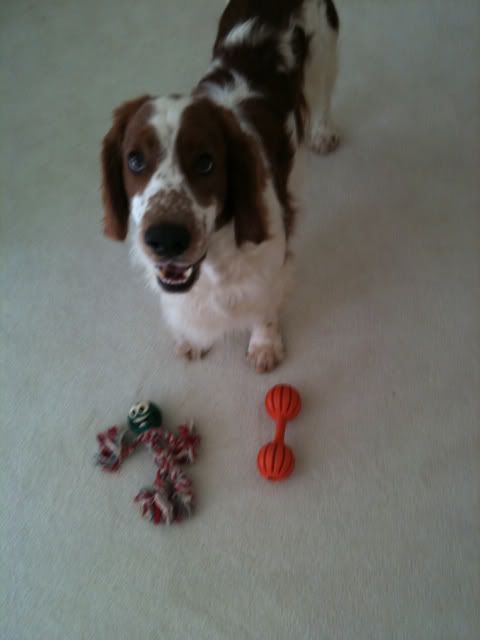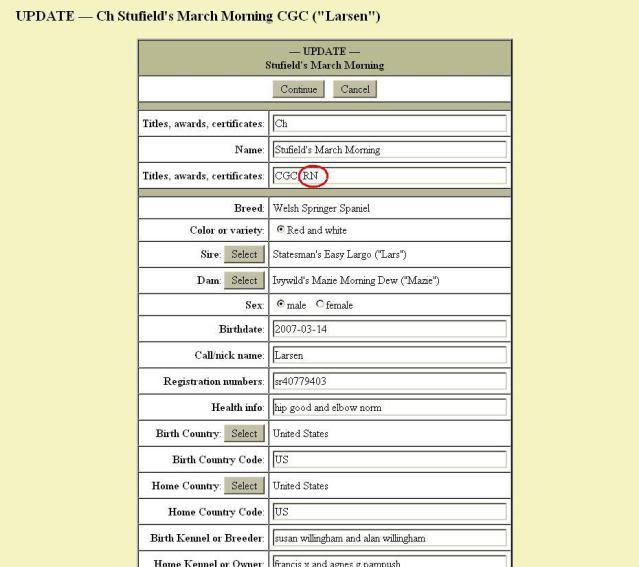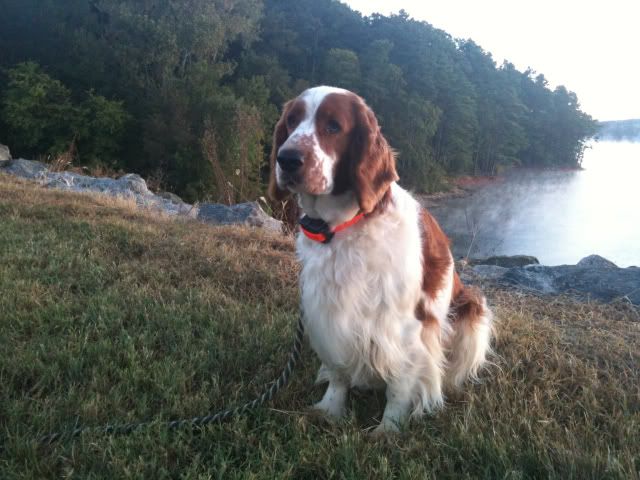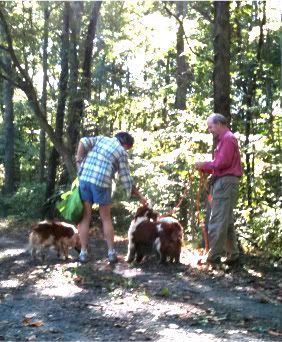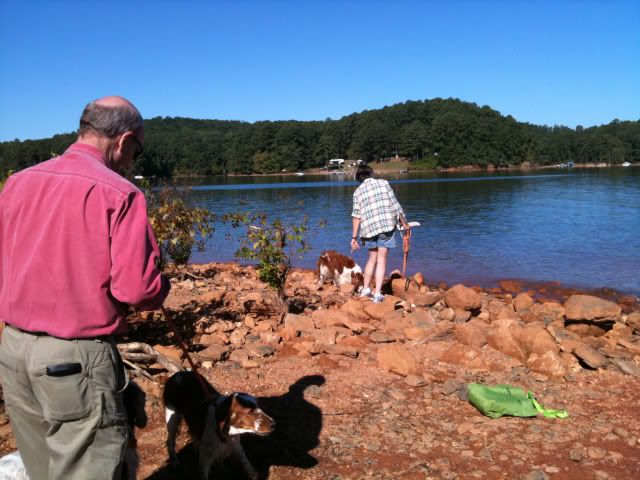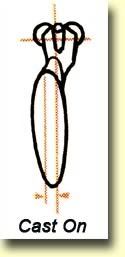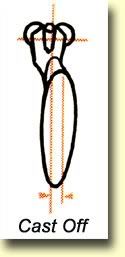Wednesday, September 29, 2010
Monday, September 27, 2010
Nosing out trouble
On occasion, you'll hear or read the question "how often do I clean a modern shotgun?" While the technical answer is "not as often as you'd think," the answer should be "Why not after you use it?" Put that gun away clean & oiled, waxed, and smelling good, and ready to go next time.
The same goes for the mutt. Giving your dog a bath is an inconvenience of sorts, but it is really a nice way to unwind from a long weekend of hiking through muddy fields; humping up and down hills; pulling sticks, dummies, and maybe a bird from the lake; and just getting into and out of trouble.
Done right, both of you can relax after dinner, fat, happy, tired, and smelling good after the day's escapades.
But what if some doggy-like odor remains? Don't ignore it. A funny smell can indicate something that needs some attention - - maybe some oral hygiene or even a staph infection.
Here's a short and interesting article on checking your little dog out from stem to stern.
You gave him the his first going over after the day's activities with the tailgate check. You checked his ears, paws, mouth, and up and down the line for burrs, ticks, and seeds. Now that he's cleaned up, use your nose as well as your eyes and fingers to check him for the little infections that can cause trouble down the line.
The same goes for the mutt. Giving your dog a bath is an inconvenience of sorts, but it is really a nice way to unwind from a long weekend of hiking through muddy fields; humping up and down hills; pulling sticks, dummies, and maybe a bird from the lake; and just getting into and out of trouble.
Done right, both of you can relax after dinner, fat, happy, tired, and smelling good after the day's escapades.
But what if some doggy-like odor remains? Don't ignore it. A funny smell can indicate something that needs some attention - - maybe some oral hygiene or even a staph infection.
Here's a short and interesting article on checking your little dog out from stem to stern.
You gave him the his first going over after the day's activities with the tailgate check. You checked his ears, paws, mouth, and up and down the line for burrs, ticks, and seeds. Now that he's cleaned up, use your nose as well as your eyes and fingers to check him for the little infections that can cause trouble down the line.
Saturday, September 25, 2010
Flashlights
A few weeks ago, Larsen and I got separated around sundown. That got me thinking about a flashlight for the backpack. When Larsen was missing (chasing deer) I had in mind one of those torches that throws a beam you can practically walk on. Of course, that is far too bright for just lighting up the trail, so you really need a multi-mode light.
There are a lot of new LED-based lights out there. I haven't selected one yet, but I'm thinking along the lines of:
100 lumens seems to be the ante for higher powered flashlights. 200-500 is for bright lighting while camping. When you go above 500 lumens you are most likely talking about a lamp like this rather than a flashlight:
I'm more interested in a candlestick flashlight. Maybe something like this, which claims to pitch at 240-280 lumens when operating at high-intensity.
This TK12 is a multi-mode flashlight. The TK12 has an "Outdoor mode" and a "Camping Mode".
Outdoor Mode:
There are a lot of new LED-based lights out there. I haven't selected one yet, but I'm thinking along the lines of:
- At least 200 lumens when switched on high. (A lumen of light is as bright as one birthday candle a foot away. The flashlight on your workbench puts out about 30 lumens. A 60 watt lightbulb = 630 lumens.)
- a high-low switch so that that the flashlight can be operated on low beam most of the time, with the turbo high-beam for emergencies.
100 lumens seems to be the ante for higher powered flashlights. 200-500 is for bright lighting while camping. When you go above 500 lumens you are most likely talking about a lamp like this rather than a flashlight:
I'm more interested in a candlestick flashlight. Maybe something like this, which claims to pitch at 240-280 lumens when operating at high-intensity.
This TK12 is a multi-mode flashlight. The TK12 has an "Outdoor mode" and a "Camping Mode".
Outdoor Mode:
- Output A: 50 Lumens/12 hours
- Output B: 240 Lumens / 1.5 hours
- Output A: 5 Lumens/120 hours
- Output B: 90 Lumens / 5.5 hours
Wednesday, September 22, 2010
Second day of autumn
In the next few weeks, it will finally get cool in the piedmont of the Appalachians. The days will get shorter with startling rapidity. The poor dry yard plants will exhale. Time for that trip to the mountains.
Tuesday, September 21, 2010
Training words
"Training regularly will go a long way towards making your luck."
Kim Parkman
"Repetition, repetition, repetition."
Susan R.
Sunday, September 19, 2010
A successful training day

Larsen enjoys the early morning run before practice begins at Circle W.
Larsen retrieved the bird to hand.
That is a success, and a glimmer of a promise that one day he will pass his 3 JH legs. Then on to SH.
The day began early for us. We got to Danny's before 7:00. I wanted to give Larsen a good chance to air it out and fool around before we buckeled down to work. The group finally gathered around 9:00am CDT. Because there were 10 of us, we split into 2 groups of 5. Our team went to the usual field.
We ran our practice session like a hunt test. We had a dog on the field, one on deck, and one in the hole, and we kept it moving.
Marylin made me keep my promise not to have any birds shot over Larsen. Finding and flushing the bird were not on the day's punch list. As Marilyn once so kindly (but I believe honestly) observed, he has a good nose and beautiful quartering. So it has to be the retrieve. What else is left?
Instead, we did shake-a-bird.
Marilyn took one end of the line and Sandy the other. I was in the middle with Larsen. I pipped him one way and another while first Marilyn and then Sandy made trilling noises and shook the bird to attract Larsen's attention. At my signal, Marilyn tossed the bird, Larsen pounced, and I pipped him in.
The retrieves were not picture perfect. Some of it was (of course) handler error. But the bottom line is retrieves they were.
This is a big, big step forward. I can now envision genuine accomplishment. I was so happy for that little dog, and, I'll admit, myself as well.
We had a very solid working group with Frank M. and his wife Deb, Sandy and Bill D., Kathy and Marilyn. Frank and Marilyn have judged HTs before so their insights and criticisms for dog and handler were absolutely invaluable. What a great September morning.
Some scenes from the practice.
Larsen tours the grounds.
Sandy and Bill share a lighter moment.
Shoni steadies herself for a shot.
Frank M. mans the right flank.
Larsen cools down after a rousing round of shake-a-bird.
Shoni gets a kiss from Sunny.
Sunny on the hunt.
Sunny quartering.
A great morning in the field.
Saturday, September 18, 2010
Practice day -1
Tomorrow Larsen and I will run some practice drills at Danny White's Circle W Hunting Preserve in Heflin, Alabama.
We're starting at the late hour of 8:30 am CDT, which is 9:30am eastern time for all practical purposes since Circle W is just inside the Alabama line. It'll hit the low to mid 90s tomorrow, so keeping an eye on the dogs will be paramount.
We're both looking forward to the camaraderie and fun of training with good friends, live birds, and live guns.
We're starting at the late hour of 8:30 am CDT, which is 9:30am eastern time for all practical purposes since Circle W is just inside the Alabama line. It'll hit the low to mid 90s tomorrow, so keeping an eye on the dogs will be paramount.
We're both looking forward to the camaraderie and fun of training with good friends, live birds, and live guns.
Friday, September 17, 2010
Back to school

Larsen is BDOC.
We cut out of work and hot-footed it to Rally Class.
Nothing new for Larsen, really. Just signed him up to get him ino the hustle and bustle of other dogs, smells, and commands. We both really enjoy it. He likes getting commanded hither and yon. It makes him concentrate. He has to puzzle a few things out. What do they say about Welshies? They need a job? Boy is that ever true.
Thursday, September 16, 2010
Auto heaven
Larsen and I walked through Keswick Park last night. Keswick is a hip-pocket park off Johnson Ferry Road near Peachtree Industrial Boulevard.
For a little fun, we decided to go cross-country. I dropped his leash, and we huffed our way up a hill that borders the park. We picked our way through the poison ivy and brambles to the top and popped out behind a cinder-block building that had a couple of cool Fords in the back lot.
You'll recognize the first one as an Edsel. It's a 1958 Bermuda station wagon! Two-tone 50's-style aqua and white color scheme with woody sides. Wouldn't that be cool to pull your dogs and gear around in?
The other is a 1964 Thunderbird. Just think about gliding into the country club in that awesome sled.
Larsen gets a laugh out of the Edsel Bermuda.
We'll have fun, fun, fun.
For a little fun, we decided to go cross-country. I dropped his leash, and we huffed our way up a hill that borders the park. We picked our way through the poison ivy and brambles to the top and popped out behind a cinder-block building that had a couple of cool Fords in the back lot.
You'll recognize the first one as an Edsel. It's a 1958 Bermuda station wagon! Two-tone 50's-style aqua and white color scheme with woody sides. Wouldn't that be cool to pull your dogs and gear around in?
The other is a 1964 Thunderbird. Just think about gliding into the country club in that awesome sled.
Larsen gets a laugh out of the Edsel Bermuda.
We'll have fun, fun, fun.
Wednesday, September 15, 2010
Touchdown
Larsen escaped from the back yard.
He took off, like he always does, for the neighbor's house. Their house has a little black & white cat (Oreo) and usually a dish of somewhat dodgy-smelling cat food. Both are big attractions.
David, Larsen's dog-walker, went out after him. Larsen was taking his usual path from one cat-friendly house to another (at top spaniel speed) and David said firmly, "Larsen! Come!" and pointed to down to his feet.
According to David, Larsen wheeled about, trotted up, and hupped.
He took off, like he always does, for the neighbor's house. Their house has a little black & white cat (Oreo) and usually a dish of somewhat dodgy-smelling cat food. Both are big attractions.
David, Larsen's dog-walker, went out after him. Larsen was taking his usual path from one cat-friendly house to another (at top spaniel speed) and David said firmly, "Larsen! Come!" and pointed to down to his feet.
According to David, Larsen wheeled about, trotted up, and hupped.
Outsmarted by a spaniel
Yes, it hurts to type those words, and I could probably have added "again" to the title.
Larsen wants to own the birds and bird wings he grabs, rather than retrieve them and turn them over to me. He needs to get more used to birds, I figure. Treat them like a fact of life. Not be so possessive. Share and share alike.
On our morning walk, I let him carry Susan's firehose & birdwing getup. Let's just walk together, old buddy, and you can carry the bird! He trotted along with that in his mouth for a long while, looking pretty good if I do say so myself. I am a dog training genius.
Then he set it down, and while I was fooling with my coffee, the leash, and being half asleep anyway, he gave that fetch toy a quick mark. Even though I rinsed it in a handy lawn sprinkler, he knew it was his, and he more or less lost interest in it. He basically said, hey, you carry that thing now, and I did for most of the walk until the end when it started drying out and he got re-interested.
Ok, two can play at this game. I'm going to get a quail out of the freezer and let you carry that around for a while. Just try marking that, buster. I'll be ready.
Larsen displays his chukar-winged firehose.
Larsen wants to own the birds and bird wings he grabs, rather than retrieve them and turn them over to me. He needs to get more used to birds, I figure. Treat them like a fact of life. Not be so possessive. Share and share alike.
On our morning walk, I let him carry Susan's firehose & birdwing getup. Let's just walk together, old buddy, and you can carry the bird! He trotted along with that in his mouth for a long while, looking pretty good if I do say so myself. I am a dog training genius.
Then he set it down, and while I was fooling with my coffee, the leash, and being half asleep anyway, he gave that fetch toy a quick mark. Even though I rinsed it in a handy lawn sprinkler, he knew it was his, and he more or less lost interest in it. He basically said, hey, you carry that thing now, and I did for most of the walk until the end when it started drying out and he got re-interested.
Ok, two can play at this game. I'm going to get a quail out of the freezer and let you carry that around for a while. Just try marking that, buster. I'll be ready.
Larsen displays his chukar-winged firehose.
Tuesday, September 14, 2010
Dial it down, boy
Here's a way to get more energy out of a recalcitrant dog: wave a bird wing under his nose.
A week or so ago, Susan W. slipped me a piece of fire hose with a pair of wings duct-taped on. Yesterday evening, I pulled that setup out and figured on a 6 foot toss & retrieve. Larsen was excited about the retrieve, to be sure, but he also slipped into his old keep-away habit. Instead of a retrieve, he took off and ran around, settled down to pluck the feathers, and overall guaranteed himself a JH flunk-out.
That sure didn't work, so we left the relative freedom of the back yard and went to the screened porch. I hupped him. I told him to take the wings. Sure! Why not? He took the wings, hupped and held. But, you could see the wheels turning as he tried to calculate if he could make a successful break to the freedom of the back yard.
Every time he even looked toward freedom, I ahemed him back to attention. Finally, I would tell him to "drop it" (his release command). Ever so slowly -- you could see the yin and yang working in the old noodle -- his jaws eased back and he gave me the wings.
We did this a bunch of times.
They say that you should keep things interesting and stop before you bore the dog, but I think Larsen could have done that wing tease all night long. He wanted to keep playing as long as he got those feathers in his mouth.
A week or so ago, Susan W. slipped me a piece of fire hose with a pair of wings duct-taped on. Yesterday evening, I pulled that setup out and figured on a 6 foot toss & retrieve. Larsen was excited about the retrieve, to be sure, but he also slipped into his old keep-away habit. Instead of a retrieve, he took off and ran around, settled down to pluck the feathers, and overall guaranteed himself a JH flunk-out.
That sure didn't work, so we left the relative freedom of the back yard and went to the screened porch. I hupped him. I told him to take the wings. Sure! Why not? He took the wings, hupped and held. But, you could see the wheels turning as he tried to calculate if he could make a successful break to the freedom of the back yard.
Every time he even looked toward freedom, I ahemed him back to attention. Finally, I would tell him to "drop it" (his release command). Ever so slowly -- you could see the yin and yang working in the old noodle -- his jaws eased back and he gave me the wings.
We did this a bunch of times.
They say that you should keep things interesting and stop before you bore the dog, but I think Larsen could have done that wing tease all night long. He wanted to keep playing as long as he got those feathers in his mouth.
Monday, September 13, 2010
Let's see a little energy
I put Larsen on the training table and told him to take the Dokken chukar. He basically looked around and past the bird, and if he could have whistled an absent-minded tune, he would've done that.
In contrast, Larsen was perfect with his other fetch toys. He took hold of the barbell, wooden rod, or PVC pipe when told to and held each one until I asked for it.
So you see, there is something he sees in the bird that bugs him. When I put the Dokken into his mouth, he holds it like a trooper - - but with no interest, excitement or anticipation of a treat or a pat.
We stepped back. Let's just fool with it. He got a treat or two right off the Dokken, and then finally, for whatever reason, he gave the fetch dummy a grab by the body like he should. Good deal. Perfect. Enough of that.
Later this morning, we played in the upstairs hallway with a few dummies, and I saw him going backward in the sense of playing with things instead of smartly picking them up and bringing them to me.
I got him excited for the Dokken - - waved it in front of him, bopped him with it, etc. I went away from him. He had to come toward me if he wanted to get the dummy. I wouldn't let him have it unless he grabbed it the right way.
That didn't happen often. Once, or possibly twice. But he did it. Praise, treat, end of session.
In contrast, Larsen was perfect with his other fetch toys. He took hold of the barbell, wooden rod, or PVC pipe when told to and held each one until I asked for it.
So you see, there is something he sees in the bird that bugs him. When I put the Dokken into his mouth, he holds it like a trooper - - but with no interest, excitement or anticipation of a treat or a pat.
We stepped back. Let's just fool with it. He got a treat or two right off the Dokken, and then finally, for whatever reason, he gave the fetch dummy a grab by the body like he should. Good deal. Perfect. Enough of that.
Later this morning, we played in the upstairs hallway with a few dummies, and I saw him going backward in the sense of playing with things instead of smartly picking them up and bringing them to me.
I got him excited for the Dokken - - waved it in front of him, bopped him with it, etc. I went away from him. He had to come toward me if he wanted to get the dummy. I wouldn't let him have it unless he grabbed it the right way.
That didn't happen often. Once, or possibly twice. But he did it. Praise, treat, end of session.
Sunday, September 12, 2010
The Dokken dead chukar is not just another retrieve dummy
A dog trainer named Tom Dokken developed a retrieve dummy made of a firm foam that is shaped somewhat like a dead bird. In fact, he has a score of these retrieve dummies in the shape of ducks, geese, and upland birds.
A sample of Dokken's dead fowl collection.
I recently got a chukar and a quail and thought I'd move Larsen from retrieving various play objects to retrieving these foam birds. Big deal, right?
I did our first little drill, which is a six-foot toss & retrieve. Larsen pounced on the foam bird and then proceeded to fool with it. This is something he does not do with ropes, dummies, or other playful retrieve objects.
Somehow, he recognized the Dokken dummy as a "bird" and he started goofing off with it. I separated dog and bird and hupped him a few times. Then I put the bird in his mouth the right way (I didn't let him dangle and swing it by the trailing string, or grab it by the head) and made him hold. I stepped away from him and called him and hupped him.
We did that simple exercise a bunch of times. He didn't seem to mind it, although I could tell he didn't like to have the bird stuffed into his mouth. When I told him to "take it", he would pick at the head or tail ends and not just grab it by the body. I could also tell that if I were to do the six-foot toss, we would go right back to simply goofing with it.
We're going to stick with the square one (hold and here boy) exercise for a bit. I'll get him on the table with it beginning in the morning, as well. I sure hope I can get him to advance before next Sunday's practice session!
Larsen hups and holds the Dokken chukar.
A sample of Dokken's dead fowl collection.
I recently got a chukar and a quail and thought I'd move Larsen from retrieving various play objects to retrieving these foam birds. Big deal, right?
I did our first little drill, which is a six-foot toss & retrieve. Larsen pounced on the foam bird and then proceeded to fool with it. This is something he does not do with ropes, dummies, or other playful retrieve objects.
Somehow, he recognized the Dokken dummy as a "bird" and he started goofing off with it. I separated dog and bird and hupped him a few times. Then I put the bird in his mouth the right way (I didn't let him dangle and swing it by the trailing string, or grab it by the head) and made him hold. I stepped away from him and called him and hupped him.
We did that simple exercise a bunch of times. He didn't seem to mind it, although I could tell he didn't like to have the bird stuffed into his mouth. When I told him to "take it", he would pick at the head or tail ends and not just grab it by the body. I could also tell that if I were to do the six-foot toss, we would go right back to simply goofing with it.
We're going to stick with the square one (hold and here boy) exercise for a bit. I'll get him on the table with it beginning in the morning, as well. I sure hope I can get him to advance before next Sunday's practice session!
Larsen hups and holds the Dokken chukar.
Wednesday, September 8, 2010
A retrieve exercise
My Labor Day outing with Susan and Allen showed me that Larsen's retrieving was below par, but that his obedience exceeded my expectations. As a result, my 5 minute exercises with him have changed a little. The focus now is on short little retrieves. Here's the new exercise.
We're doing this new exercise with different objects.
Larsen inspects the barbell and rope man fetch toys.
The barbell and rope-man have different feels. The barbell is rubbery and rope-man is ropey. I have in inventory a hard dumbbell, a piece of wood, and a piece of PVC pipe and a quail wing taped around a piece of firehose, which will get deployed at some point.
As he progresses, I'll ask him to fetch it up from greater distances and with distractions.
At some point, when he's having success with everything else, he'll get a dead quail that currently is in the freezer.
- Hup him.
- Toss one or two objects about 6 feet away.
- Tell him to get one of them.
- When he grabs it, let him bring them in. If he dawdles even a second, give him a triple tweet and some pats on my thigh to tell him to come in.
- Make him hold & hup.
- If everything is a success (and he doesn't spit it out), praise him, but don't give him a treat. (If you tossed two objects, tell him to get the second one.)
- After all of the fetching and hupping is done, step a few feet away. Call him and hup him.
- Do this again. Then give him praise and maybe a treat.
We're doing this new exercise with different objects.
Larsen inspects the barbell and rope man fetch toys.
The barbell and rope-man have different feels. The barbell is rubbery and rope-man is ropey. I have in inventory a hard dumbbell, a piece of wood, and a piece of PVC pipe and a quail wing taped around a piece of firehose, which will get deployed at some point.
As he progresses, I'll ask him to fetch it up from greater distances and with distractions.
At some point, when he's having success with everything else, he'll get a dead quail that currently is in the freezer.
Tuesday, September 7, 2010
The brainiacs are at it again
The ivory tower provides yet one more reason to train your dog in multiple locations.
Despite our different training venues, Larsen does not associate the Treaty of Versailles with much of anything.
Benedict Cary, "Forget What You Know About Good Study Habits," New York Times, Published: September 6, 2010.
Despite our different training venues, Larsen does not associate the Treaty of Versailles with much of anything.
"The brain makes subtle associations between what it is studying and the background sensations it has at the time, the authors say, regardless of whether those perceptions are conscious. It colors the terms of the Versailles Treaty with the wasted fluorescent glow of the dorm study room, say; or the elements of the Marshall Plan with the jade-curtain shade of the willow tree in the backyard. Forcing the brain to make multiple associations with the same material may, in effect, give that information more neural scaffolding.
“What we think is happening here is that, when the outside context is varied, the information is enriched, and this slows down forgetting,” said Dr. Bjork, the senior author of the two-room experiment.
Varying the type of material studied in a single sitting — alternating, for example, among vocabulary, reading and speaking in a new language — seems to leave a deeper impression on the brain than does concentrating on just one skill at a time. Musicians have known this for years, and their practice sessions often include a mix of scales, musical pieces and rhythmic work. Many athletes, too, routinely mix their workouts with strength, speed and skill drills."
Benedict Cary, "Forget What You Know About Good Study Habits," New York Times, Published: September 6, 2010.
Monday, September 6, 2010
Rally novice title
Larsen earned three legs and his Rally Novice title in the Cherokee Rose Cluster on August 27-29. I was able to update his profile on the Pedigree Engine. He did a nice job that weekend.
Sunday, September 5, 2010
Dummy practice
I caught up with Susan and Allen W. to give our dogs a little bumper work at Lake Allatoona this morning. I brought Larsen. Susan and Allen brought Lars and Mazie, Larsen's sire & dam, and Tatum. We did some bumper retrieves on land and water.
Larsen's retrieving was nothing to write home about. Certainly not where he needs to be for October, but there were some solid things to build on:
I'll also make sure I get him on the table every day to pick something up and hold it. We'll repeat retrieves, pick-ups, and holds every day for the next few weeks.
Tatum set a great example for both land and water. She's a very eager little dog who clearly enjoys any type of field work. Mazie is simply fun to watch. She's very accomplished and responds to the whistle with a beautiful nonchalance - - as though she herself independently had determined to do the very thing that the whistle asked of her.
It was a nice time and, like any group training no matter how small, renews your enthusiasm for the work.
Larsen hups along the berm of Lake Allatoona.
Susan and Allen prepare the dogs for some retrieve work.
Larsen waits.
Dogs can be circumspect and even obstinate when asked to retrieve, but are always indescribably eager when asked to wait their turns.
Mazie completes a water retrieve while Allen and Tatum observe.
Larsen's retrieving was nothing to write home about. Certainly not where he needs to be for October, but there were some solid things to build on:
- Larsen minded my commands, including commands to come, even when he was otherwise preoccupied with the lithesome Tatum.
- Larsen would return to me, hup, and then head back out when I resent him for a bumper (albeit one he had failed to return).
- When Larsen didn't feel like picking up the bumper, he made moaning and groaning sounds, but did it anyway.
I'll also make sure I get him on the table every day to pick something up and hold it. We'll repeat retrieves, pick-ups, and holds every day for the next few weeks.
Tatum set a great example for both land and water. She's a very eager little dog who clearly enjoys any type of field work. Mazie is simply fun to watch. She's very accomplished and responds to the whistle with a beautiful nonchalance - - as though she herself independently had determined to do the very thing that the whistle asked of her.
It was a nice time and, like any group training no matter how small, renews your enthusiasm for the work.
Larsen hups along the berm of Lake Allatoona.
Susan and Allen prepare the dogs for some retrieve work.
Larsen waits.
Dogs can be circumspect and even obstinate when asked to retrieve, but are always indescribably eager when asked to wait their turns.
Mazie completes a water retrieve while Allen and Tatum observe.
Friday, September 3, 2010
Castaway
I sent my 20 gauge to Beretta to get it restocked to fit a left-handed shooter. I got it back today and will try it out on Saturday morning.
Most gun stocks are straight, but on better guns the stocks are subtly bent in one direction or the other. This is called cast. The bend is about 1/8 of an inch or maybe 1/4 inch, so we are not talking about a banana. You might not really even notice it if you glanced at it. (These sketches are courtesy of Bill Hanus's website.) Left handed shooters may use "cast on" while right-handed shooters would use "cast off".
What the bend, or cast, is intended to do is allow a more natural alignment of the shooter's dominant eye along the ridge of the gun. You don't sight a shotgun as you do a rifle. Instead you look along straight along the line of the barrels, without looking at the barrels, at the object you would like to hit. Just as you don't look at the bat in baseball or the racket in tennis, you look at the object you want to hit. When you have a consistent and accurate alignment of the eye, the barrel, and the lead hand, you have a better chance of hitting the bird or the clay.
When cast is absent (or goes the wrong way) you might cant or twist the barrels of an over-under gun. This aligns the top barrel with your eye, but the bottom barrel is out of the vertical plane and presto, your first shot (usually from that bottom barrel) is off.
I don't want to oversell what cast will do for me or anyone else. One of the better shooters that I know is totally indifferent to cast. He is left handed, but shoots the guns right off the rack. He said that at one time he went through the whole ritual of making minuscule adjustments, but nowadays he just shoots.
Of course, his is similar to the story that Lee Trevino would win bets by using a taped-up Coke bottle on the end of a chain to out-drive other golfers. It can be done, but not by me.
Most gun stocks are straight, but on better guns the stocks are subtly bent in one direction or the other. This is called cast. The bend is about 1/8 of an inch or maybe 1/4 inch, so we are not talking about a banana. You might not really even notice it if you glanced at it. (These sketches are courtesy of Bill Hanus's website.) Left handed shooters may use "cast on" while right-handed shooters would use "cast off".
What the bend, or cast, is intended to do is allow a more natural alignment of the shooter's dominant eye along the ridge of the gun. You don't sight a shotgun as you do a rifle. Instead you look along straight along the line of the barrels, without looking at the barrels, at the object you would like to hit. Just as you don't look at the bat in baseball or the racket in tennis, you look at the object you want to hit. When you have a consistent and accurate alignment of the eye, the barrel, and the lead hand, you have a better chance of hitting the bird or the clay.
When cast is absent (or goes the wrong way) you might cant or twist the barrels of an over-under gun. This aligns the top barrel with your eye, but the bottom barrel is out of the vertical plane and presto, your first shot (usually from that bottom barrel) is off.
I don't want to oversell what cast will do for me or anyone else. One of the better shooters that I know is totally indifferent to cast. He is left handed, but shoots the guns right off the rack. He said that at one time he went through the whole ritual of making minuscule adjustments, but nowadays he just shoots.
Of course, his is similar to the story that Lee Trevino would win bets by using a taped-up Coke bottle on the end of a chain to out-drive other golfers. It can be done, but not by me.
Wednesday, September 1, 2010
Shut out of regionals
I had thought that if Larsen got a leg on Rally he would be eligible for something having to do with a hunting test invitational on Saturday in October at the regional Welsh Springer Spaniel show in Perry, Ga. I was mistaken. He's eligible for something having to do with Rally.
That's great. I may concentrate on preparing for the following Monday's open hunting test at the regionals. We'll see.
Our preparation will involve working on the retrieve.
Time to get back to the bench and to the field with dowels and dummies. September is here, even the daytime 90s seem cooler, and it's time to buckle down.
That's great. I may concentrate on preparing for the following Monday's open hunting test at the regionals. We'll see.
Our preparation will involve working on the retrieve.
Time to get back to the bench and to the field with dowels and dummies. September is here, even the daytime 90s seem cooler, and it's time to buckle down.
Subscribe to:
Comments (Atom)











